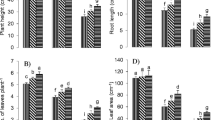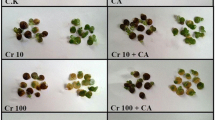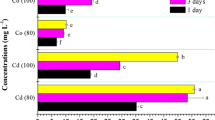Abstract
Phytoremediation is a green technology for the remediation of contaminated ecosystems by using plants. In the present study, a hydroponic experiment was conducted to investigate the phytoremediation potential of eight canola (Brassica napus L.) cultivars for hexavalent chromium [Cr(VI)]. Chromium significantly affected dry weight, lipid peroxidation, chlorophylls, non-protein thiol and antioxidant enzymes. Based on the dry weight, the tolerance index was found maximum in cultivar (cv.) NK Petrol and minimum in cv. Sary. The cv. Sary accumulated the maximum amount of Cr (705.8 μg g−1 DW), which was correlated with the lowest levels of chlorophyll content and highest levels of lipid peroxidation. However, Cr accumulation was lowest (255.0 μg g−1 DW) in NK Petrol. Although cv. NK Petrol may be a Cr(VI) excluder relative to cv. Sary, it may have the potential for the phytoremediation of Cr-contaminated sites as it possesses higher resistance to Cr(VI) by producing higher biomasses.
Similar content being viewed by others
Explore related subjects
Discover the latest articles, news and stories from top researchers in related subjects.Avoid common mistakes on your manuscript.
Presently, heavy metal pollution of the biosphere caused by various human activities has accelerated rapidly and the resulting soil contamination causes major environmental problems. In particular, chromium (Cr) has accumulated among others in agriculturally used soils due to electroplating, metal finishing, corrosion control, leather tanning, and pigment manufacturing industries (Shanker et al. 2005). This contamination with Cr has become an important environmental concern throughout the world due to its potential adverse effects on human and animal health (Tiwari et al. 2013). Therefore, the remediation of Cr-contaminated soils is required reducing related risks. In this context, phytoremediation, which takes advantage of hyperaccumulator or accumulator plants to remove metals from soil, represents an alternative to engineering procedures that are considered more destructive to soils (Chaney et al. 2007). The efficiency of phytoremediation, however, depends on biomass production and the possibility to accumulate metals in harvestable organs of the selected plant species (Blaylock et al. 1997). Some members of Brassica genus, such as canola (Brassica napus) and Indian mustard (B. juncea) are well known as metal accumulators and have been investigated for the accumulation of heavy metals such as Cd, As, Hg, Pb, Cr, Cu, Zn and Ni (Diwan et al. 2008; Yu et al. 2012). However, the potential of canola for phytoremediation of Cr has not been assessed yet. The objectives of this research were therefore to determine the Cr-tolerance and -bioaccumulative potential of 8 canola cultivars as well as to compare their phytoremediation potential.
Materials and Methods
Seeds of eight cultivars (Champlain, Dante, Heros, Nelson, NK Petrol, Sary, Süzer and Vectra) of canola (Brassica napus L.) were obtained from National Seed Corporations and Trakya Agricultural Research Institute in Turkey. The seeds were germinated in paper towels in dark at 23 ± 1°C, and uniform germinated seeds were transferred to 1 L plastic pots with nutrient solution of the following composition (Diwan et al. 2008): 2.4 mM Ca(NO3)2, 1.0 mM KH2PO4, 3.0 mM KNO3, 1.0 mM MgSO4, and 0.5 mM NaCl and 23.1 μM H3BO3, 4.6 μM MnCl2, 0.38 μM ZnSO4, 0.16 μM CuSO4, 0.052 μM H2MoO4, and 44.8 μM FeNa2EDTA. The seedlings were then grown hydroponically in a growth chamber under controlled environmental conditions (23 ± 1°C, at a relative humidity of 60 %, and a 16 h photoperiod with photosynthetically active radiation at photon flux density of 260 μmol m−2 s−1) for 2 weeks. The pH of the nutrient solution was adjusted to 6.0 ± 0.1 using 0.05 M KOH, and the nutrient solution was renewed every other day. Preliminary experiments with Cr(VI) at 0–300 μM was carried out to determine the appropriate test concentrations. Based on growth inhibition, the nominal Cr(VI) concentrations of 0 (control), 10, 50 and 100 μM supplied as potassium dichromate were selected. To determine Cr concentrations, nutrient solutions with Cr(VI) were acidified with redistilled nitric acid. Cr concentrations were determined by an inductively coupled plasma-optical emission spectroscopy (ICP-OES, PerkinElmer Optimal 2100DV). Analytical limit of detection was 0.05 mg L−1 for Cr. Mean measured chromium concentrations in the treatment solutions were 9.3, 47.5 and 94.4 μM, which were 93 %–95 % of nominal concentrations (Table 1).
Ten seedlings from each replicate were harvested at day 7 of Cr(VI) exposure, and they were used to assess the following endpoints. The seedlings were dried at 80 ± 2°C for 48 h to determine dry weight (DW). The DW was determined on a digital balance, with precision of 0.1 mg (Ohaus Adventurer Pro AV264, Pine Brook, NJ). The tolerance index values (%) were calculated as the mean DW of Cr(VI)-stressed plants relative to mean DW of control plants. For the Cr accumulation analyses, the dried samples (1 g) were acid digested in HNO3. The Cr accumulation (μg g−1 DW) in aerial parts was determined by ICP-OES after microwave (Berghof, Germany) digestion according to NMKL (1998) with some modifications. Chromium standard solutions were prepared by diluting 1,000 ppm standard (Inorganic Ventures, Christiansburg, VA, USA; CGCR(3)1-1, Lot # A2-CR03007), and they were utilized to calibration and quality assurance. Analytical data quality of metal was ensured with repeated analysis of quality control samples (n = 3) and the results were within the certified values. Analytical limit of detection was 0.05 mg L−1 for Cr. The analytical recovery range of Cr was 96.9 %, which was measured up to the analytical demand (QA/QC).
Plant tolerance to metals is the key characteristic required for hyperaccumulation of metals, and the tolerance capacity of plants to heavy metals depends on strong antioxidant defense system (Pandey et al. 2005), which was assessed by the following biomarker analysis: Malondialdehyde (MDA) is one of the final decomposition products of lipid peroxidation and may hence serve as a suitable proxy for this endpoint. Lipid peroxidation in leaf tissues (250 mg) was measured in terms of MDA determined by thiobarbituric acid (TBA) reactions as described by Heath and Packer (1968). Chlorophyll content is an important indicator of plant growth status under heavy metal stress. Total chlorophylls (Chl a + b) in leaf tissues (100 mg) were extracted and estimated according to Wellburn (1994). Non-protein thiol (NPT) binds with the metal ions and helps to reduce toxicity. NPT were estimated according to Nagalakshmi and Prasad (2001) with some modifications described in Zhang et al. (2009). Superoxide dismutase (SOD; EC: 1.15.1.1) activity was assayed on the basis of its ability to inhibit the photochemical reduction of nitro blue tetrazolium (Beauchamp and Fridovich 1971). One unit of SOD activity was defined as the amount of enzyme that caused 50 % inhibition of the reaction rate in the absence of the enzyme. Guaiacol peroxidase (POD; EC: 1.11.1.7) activity was measured following Chance and Maehly (1955). The POD reaction solution contained 50 mM phosphate buffer (pH 5.0), 20 mM guaiacol, 40 mM H2O2, and enzyme extract. The activity was calculated from the change in absorbance at 470 nm for 3 min. The activity of catalase (CAT; EC: 1.11.1.6) was assayed following H2O2 decomposition at 240 nm for 3 min according to Aebi (1984). Finally, protein concentration of the supernatant was determined according to Bradford (1976) using bovine serum albumin as a standard.
All experiments were performed in triplicate and repeated twice. All data were subjected to two-way analysis of variance using SPSS.17 (SPSS Inc., Chicago, IL, USA). Duncan’s multiple range test (DMRT) at 5 % probability was employed for assessing the significant differences among the mean values.
Result and Discussion
Analysis of variance (ANOVA) indicated that there were significant (p < 0.001) individual effects of cultivars, Cr(VI), and their interactions on all endpoints tested (Table 2). In the present study, genotypic variations among 8 canola (Brassica napus L.) cultivars in terms of their differential tolerance to the Cr(VI) stress were studied. The most common effect of Cr(VI) toxicity is growth inhibition, leaf chlorosis and alteration in the activity of many enzymes of various metabolic pathways (Tiwari et al. 2013). A significant (p < 0.05) reduction in growth in terms of DW was observed as compared to controls (Table 3). Reductions in DW varied among genotypes from 18 % to 34 %, 20 % to 49 % and 26 % to 59 % at 10, 50 and 100 μM Cr(VI), respectively. Moreover, the tolerance index was maximum (82.5 %–74.1 %) in NK Petrol and minimum (65.7 %–40.8 %) in Sary at all Cr(VI) concentrations, indicating that NK Petrol has a higher level of tolerance to Cr(VI)-induced stress, whereas Sary is highly sensitive (Table 3). The phytoremediation potential of canola cultivars was evaluated with reference to Cr accumulation. Our results showed that all canola cultivars accumulated more than 255.0 μg Cr g−1 DW in their aerial parts at 100 μM Cr(VI) (Table 3). At 100 μM Cr(VI), the maximum Cr accumulation was found in Sary (705.8 μg g−1 DW) whereas the minimum Cr accumulation was found in NK Petrol (255.0 μg g−1 DW). However, results from hydroponic experiments cannot be directly inferred to natural conditions (Hernández-Allica et al. 2008). In soil, high concentrations of bioavailable Cr will limit the utilization of fully matured plants of Sary, because of Cr(VI) phytotoxicity impeding proper growth. Therefore, it must be emphasized that the phytoremediation potential of high biomass cultivars depends not only on their ability to accumulate metals in their aerial parts but also on their capacity to tolerate relatively high soil metal concentrations (Hernández-Allica et al. 2008). Hence, cv. NK Petrol may—although a Cr(VI) excluder relative to cv. Sary—have the potential for the phytoremediation of Cr-contaminated sites as it possesses higher resistance to Cr(VI) by producing more biomasses. However, when using crops for phytoremediation, the disposal of metal-containing biomass should be considered. Recently, it has been suggested that the obtained biomass of a phytoremediation process may be used for energy production purposes rather than for conventional applications such as food or feed (Zhang et al. 2013).
Heavy metals may cause molecular damage to plant cells either directly or indirectly through the formation ROS (Pandey et al. 2009). Membrane lipids are especially prone to attack by ROS. The formation of MDA, a major cytotoxic product of lipid peroxidation acts as an indicator of peroxidation of membrane lipids in plants (Singh et al. 2004). In the present study, the MDA content was significantly (p < 0.05) enhanced in Cr(VI)-stressed seedlings indicating enhanced lipid peroxidation (Table 4). This increase was maximum in Sary (2.4-fold) and minimum in NK Petrol (1.5-fold) at 100 μM Cr(VI) as compared to the controls. Chlorophyll content decreased significantly (p < 0.05) in canola cultivars with increasing Cr(VI) concentrations (Table 4). A maximum decline was observed in Sary (21 %–69 %). This reduction can be attributed to the oxidative stress generated by Cr(VI) as several investigators have reported chlorophyll depletion following Cr(VI)-induced oxidative stress (Vajpayee et al. 2000; Yıldız et al. 2013). However, NK Petrol could protect the chlorophyll content under increasing Cr(VI) concentrations. As a result, increased MDA content and decreased chlorophyll content in Sary indicates that Sary is highly sensitive to Cr(VI) stress as is evident by their stunted growth. It has been reported that low molecular weight sulfhydryl-containing compounds such as cysteine and glutathione play an important role in heavy metal detoxification (Cobbett and Goldsbrough 2002). In the present study, NPT levels were enhanced in Cr(VI)-stressed seedlings as compared to controls indicating thiol-enriched compounds are synthesized in canola seedlings under Cr(VI) stress (Table 4). The maximum increase in NPT content was observed in NK Petrol (42 %–54 %) among Cr(VI)-stressed canola cultivars.
To overcome the heavy metal induced oxidative stress, plants possess antioxidant defense system including enzymatic and non-enzymatic antioxidants. The concurrently function of these antioxidants play an important role in scavenging ROS and maintaining the physiological redox status (Pandey et al. 2009). In the present study, a significant (p < 0.05) enhancement in SOD activity was observed in Cr(VI)-stressed canola seedlings (Table 5). However, SOD activity was more pronounced in NK Petrol and Sary indicating that its efficient may not related to Cr(VI) tolerance. POD activity was significantly (p < 0.05) elevated by Cr(VI) treatments in all canola cultivars (Table 5). Comparing the POD activities, susceptible cultivar Sary has a higher POD activity as compared to control. It is suggested that more Cr accumulation in sensitive cultivar Sary may be attributed to the enhanced POD activity. A significant (p < 0.05) decrease in catalase activity was observed in Cr(VI)-stressed seedlings as compared to control (Table 5). The decrease in CAT activity was in agreement with the result reported by Yıldız et al. (2013). The decrease in the activity of the CAT enzyme might be a result of the inhibitory effect of Cr ions on the enzyme system itself or an affinity of Cr ions to thiol compounds disturbing protein synthesis and enzyme activity (MacRae and Fergusam 1985). However, NK Petrol, being the relatively more tolerant cultivar, maintained the CAT activity under Cr(VI) stress.
In conclusion, the phytoremediation performance of canola cultivars varied significantly depending on the investigated parameters. NK Petrol accumulated the lowest levels of Cr, and it might be a Cr excluder with a capacity to tolerate Cr(VI) stress. Under natural conditions, however, success of phytoremediation does not only depend on the ability of plants to accumulate metals in their aerial parts but also on their capacity to tolerate relatively high soil metal concentrations. Therefore, it may be assumed that NK Petrol might be used for phytoremediation of Cr-contaminated soils with an ability to tolerate Cr(VI) toxicity and accumulated considerably amounts of Cr.
References
Aebi H (1984) Catalase in vitro. Method Enzymol 105:121–126
Beauchamp C, Fridovich I (1971) Superoxide dismutase: improved assays and an assay applicable to acrylamide gels. Anal Biochem 44:276–287
Blaylock MJ, Salt DE, Dushenkov S, Zakharova O, Gussman C, Kapulnik Y, Ensley BD, Raskin I (1997) Enhanced accumulation of Pb in Indian mustard by soil-applied chelating agents. Environ Sci Technol 31:860–865
Bradford MN (1976) A rapid and sensitive method for the quantitation of microgram quantities of protein utilizing the principle of protein–dye binding. Anal Biochem 72:248–254
Chance B, Maehly AC (1955) Assay of catalase and peroxidase. In: Colowick SP, Kaplan NO (eds) Methods in enzymology, 2nd edn. Academic Press, New York, pp 764–775
Chaney RL, Angle JS, Broadhurst CL, Peters CA, Tappero RV, Sparks DL (2007) Improved understanding of hyperaccumulation yields commercial phytoextraction and phytomining technologies. J Environ Qual 36:1429–1443
Cobbett C, Goldsbrough P (2002) Phytochelatin and metallothioneins: roles in heavy metal detoxification and homeostasis. Ann Rev Plant Biol 53:159–182
Diwan H, Ahmad A, Iqbal M (2008) Genotypic variation in the phytoremediation potential of Indian mustard for chromium. Environ Manage 41:734–741
Heath RL, Packer L (1968) Photoperoxidation in isolated chloroplasts I. Kinetics and stoichiometry of fatty acid peroxidation. Arch Biochem Biophys 125:189–198
Hernández-Allica J, Becerril JM, Garbisu C (2008) Assessment of the phytoextraction potential of high biomass crop plants. Environ Pollut 152:32–40
MacRae EA, Fergusam IB (1985) Changes in catalase activity and H2O2 concentration in plants in response to low temp. Physiol Plant 65:51–56
Nagalakshmi N, Prasad MNV (2001) Responses of glutathione cycle enzymes and glutathione metabolism to copper stress in Scenedesmus bijugatus. Plant Sci 160:291–299
NMKL (1998) Metals: determination by atomic adsorption spectrophotometry after wet digestion in microwave oven. In: NMKL Method No. 161, Nordic Committee on Food Analysis, Norway, p 8
Pandey V, Dixit V, Shyam R (2005) Antioxidative responses in relation to growth of mustard (Brassica juncea cv. Pusa Jai Kisan) plants exposed to hexavelant chromium. Chemosphere 61:40–47
Pandey V, Dixit V, Shyam R (2009) Chromium effect on ROS generation and detoxification in pea (Pisum sativum) leaf chloroplasts. Protoplasma 236:85–95
Shanker AK, Cervantes C, Loza-Tavera H, Avudainayagam S (2005) Chromium toxicity in plants. Environ Int 31:739–753
Singh KP, Mohan D, Sinha S, Dalwani R (2004) Impact assessment of treated/untreated wastewater toxicants discharged by sewage treatment plants on health agricultural and environmental quality in the wastewater disposal area. Chemosphere 55:227–255
Tiwari KK, Singh NK, Rai UN (2013) Chromium phytotoxicity in radish (Raphanus sativus): effects on metabolism and nutrient uptake. Bull Environ Contam Toxicol 91:339–344
Vajpayee P, Tripathi RD, Rai UN, Ali MB, Singh SN (2000) Chromium(VI) accumulation reduces chlorophyll biosynthesis, nitrate reductase activity and protein content in Nymphaea alba L. Chemosphere 41:1075–1082
Wellburn AR (1994) The spectral determination of chlorophylls a and b, as well as total carotenoids, using various solvents with spectrophotometers of different resolution. J Plant Physiol 144:307–313
Yıldız M, Terzi H, Bingül N (2013) Protective role of hydrogen peroxide pretreatment on defense systems and BnMP1 gene expression in Cr(VI)-stressed canola seedlings. Ecotoxicology 22:1303–1312
Yu R, Ji J, Yuan X, Song Y, Wang C (2012) Accumulation and translocation of heavy metals in the canola (Brassica napus L.)—soil system in Yangtze River Delta China. Plant Soil 353:33–45
Zhang H, Lian C, Shen Z (2009) Proteomic identification of small, copper-responsive proteins in germinating embryos of Oryza sativa. Ann Bot 103:923–930
Zhang H, Tian Y, Wang L, Zhang L, Dai L (2013) Ecophysiological characteristics and biogas production of cadmium-contaminated crops. Bioresource Technol 146:628–636
Acknowledgments
This research was financially supported by the Afyon Kocatepe University Research Fund (Project No. 12.FEN.BIL.01). The authors also wish to thank Afyon Kocatepe University’s Foreign Language Support Unit for some language editing.
Author information
Authors and Affiliations
Corresponding author
Rights and permissions
About this article
Cite this article
Terzi, H., Yıldız, M. Variations in Chromium Tolerance and Accumulation among Canola (Brassica napus L.) Cultivars. Bull Environ Contam Toxicol 93, 113–119 (2014). https://doi.org/10.1007/s00128-014-1255-0
Received:
Accepted:
Published:
Issue Date:
DOI: https://doi.org/10.1007/s00128-014-1255-0




